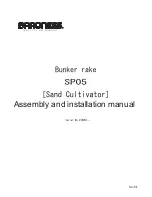
D-EIMWC01008-16_03EN - 5/35
1
INTRODUCTION
This manual is an important supporting document for qualified personnel but it is not intended to replace such
personnel.
READ THIS MANUAL CAREFULLY BEFORE INSTALLING AND STARTING UP THE UNIT.
IMPROPER INSTALLATION COULD RESULT IN ELECTRIC SHOCK, SHORT-CIRCUIT,
LEAKS, FIRE OR OTHER DAMAGE TO THE EQUIPMENT OR INJURE TO PEOPLE.
THE UNIT MUST BE INSTALLED BY A PROFESSIONAL OPERATOR/TECHNICIAN
UNIT STARTUP HAS TO BE PERFORMED BY AUTHORIZED AND TRAINED
PROFESSIONAL
ALL ACTIVITIES HAVE TO BE PERFORMED ACCORDING TO LOCAL LAWS AND
REGULATION.
UNIT INSTALLATION AND START UP IS ABOSOLUTELY FORBIDDEN IF ALL
INSTRUCTION CONTAINED IN THIS MANUAL ARE NOT CLEAR.
IF CASE OF DOUBT CONTACT THE MANUFACTURER REPRESENTATIVE FOR ADVICE
AND INFORMATION.
1.1
Precautions against residual risks
1. install the unit according to the instructions set out in this manual
2. regularly carry out all the maintenance operations foreseen in this manual
3. wear protective equipment (gloves, eye protection, hard hat, etc.) suited to the work in hand; do not wear clothes
or accessories that can get caught or sucked in by flows of air; tie back long hair before entering the unit
4. before opening the machine panelling make sure that it is firmly hinged to the machine
5. the fins on heat exchangers and the edges of metal components and panels can cause cuts
6. do not remove the guards from mobile components while the unit is operating
7. make sure that mobile component guards are fitted correctly before restarting the unit
8. fans, motors and belts drives might be running: before entering, always wait for these to stop and take appropriate
measures to prevent them from starting up
9. the surfaces of the machine and pipes can get very hot or cold and cause the risk of scalding
10. never exceed the maximum pressure limit (PS) of the water circuit of the unit.
11. before removing parts on the pressurised water circuits, close the section of the piping concerned and drain the
fluid gradually to stabilise the pressure at the atmospheric level
12. do not use your hands to check possible refrigerant leaks
13. disable the unit from the mains using the main switch before opening the control panel
14. check that the unit has been grounded correctly before starting it
15. install the machine in a suitable area; in particular, do not install it outdoors if it is intended for use indoors
16. do not use cables with inadequate sections nor extension co rd connections, even for very short periods or
emergencies
17. for units with power correction capacitors, wait 5 minutes after removing the electric power supply before
accessing the inside of the switch board
18. if the unit is equipped with compressors with integrated inverter, disconnect it from the mains and wait a minimum
of 20 minutes before accessing it to carry out maintenance: residual energy in the components, which takes at
least this length of time to dissipate, poses the risk of electrocution
19. the unit contains pressurised refrigerant gas: the pressurised equipment must not be touched except during
maintenance, which must be entrusted to qualified and authorised personnel
20. connect up the utilities to the unit following the indications set out in this manual and on the panelling of the unit
itself
21. In order to avoid an environmental risk, make sure that any leaking fluid is collected in suitable devices in
accordance with local regulations.
22. if a part needs to be dismantled, make sure it is correctly re-assembled before starting the unit
23. when the rules in force require the installation of fire -fighting systems near the machine, check that these are
suitable for extinguishing fires on electrical equipment and on the lubricating oil of the compressor and the
refrigerant, as specified on the safety data sheets of these fluids
24. when the unit is equipped with devices for venting overpressure (safety valves): when these valves are triggered,
the refrigerant gas is released at a high temperature and speed; prevent the release of gas from harming people
or objects and, if necessary, discharge the gas according to the provisions of EN 378-3 and the local regulations
in force.
25. keep all the safety devices in good working order and check them periodically according to the regulations in force
26. keep all lubricants in suitably marked containers
27. do not store inflammable liquids near the unit
28. solder or braze only empty pipes after removing all traces of lubricant oil; do not use flames or other heat sources
in the vicinity of pipes containing refrigerant fluid
29. do not use naked flames near the unit






































